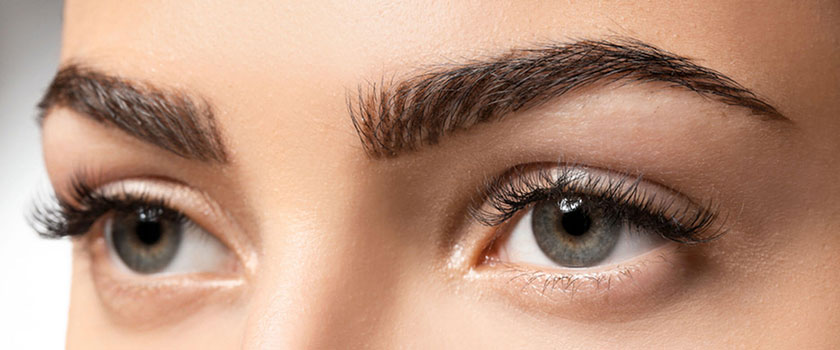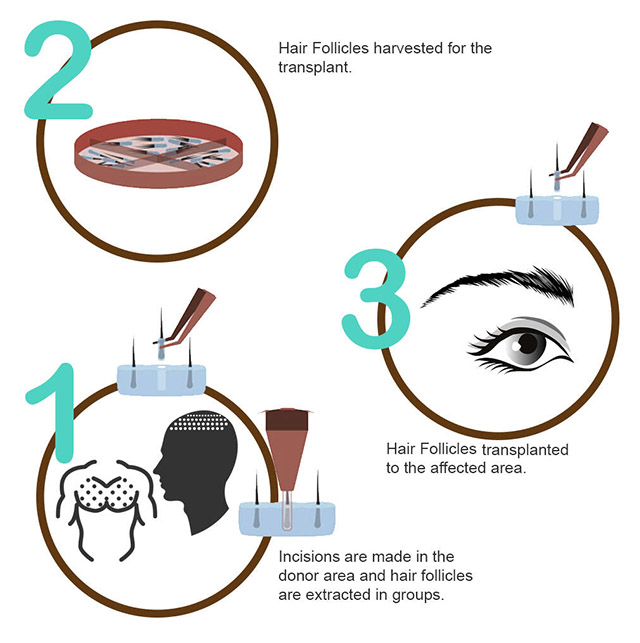Wat is wenkbrauwtransplantatie?
Om de dichtheid en vorm van de wenkbrauwen te verbeteren, houdt wenkbrauwtransplantatie in dat haarzakjes van de hoofdhuid chirurgisch naar het wenkbrauwgebied worden getransplanteerd. Er wordt een micro-punch instrument gebruikt om haarzakjes te verwijderen, die vervolgens via kleine incisies onder lokale verdoving in de wenkbrauwen worden getransplanteerd.
De operatie behandelt littekens, overmatig epileren en dunner wordende wenkbrauwen. De techniek produceert meestal na vele maanden grotere, beter gedefinieerde wenkbrauwen.

Wat zijn de voordelen van wenkbrauwtransplantatie in Turkije?
Turkije biedt verschillende voordelen voor wenkbrauwtransplantatie:
- Expertise: Turkije is een centrum voor esthetische operaties, waaronder wenkbrauwtransplantatie. Verschillende wenkbrauwtransplantchirurgen in het land zijn zeer getalenteerd en ervaren.
- Kosteneffectief: Vergeleken met de VS en Europa is wenkbrauwtransplantatie in Turkije goedkoper.
- Nieuwste Technologie: Turkse haartransplantklinieken gebruiken de nieuwste technologie en procedures in wenkbrauwtransplantatie, zoals het FUE (Follicular Unit Extraction) proces, dat littekens vermindert en een natuurlijk uiterlijk garandeert.
- Hoogwaardige faciliteiten: Turkije biedt tal van moderne klinieken en ziekenhuizen met geavanceerde medische technologie en faciliteiten om de veiligheid en het comfort van patiënten te waarborgen.
- Toerisme: Verschillende klinieken bieden pakketten aan die de operatie, accommodatie en vervoer in Turkije, een populaire vakantiebestemming, omvatten. Patiënten kunnen genieten van een vakantie op een mooie plek terwijl ze behandeling krijgen.
- Snel herstel: Na een wenkbrauwtransplantatie in Turkije kunnen patiënten binnen enkele dagen hun normale activiteiten hervatten.
Turkije is een populaire locatie voor wenkbrauwtransplantatie vanwege de kwaliteit, prijs en comfort.

Wat zijn de opties voor wenkbrauwtransplantatie in Turkije?
Turkije biedt opties voor wenkbrauwtransplantatie:
- FUE Wenkbrauwtransplantatie is de meest voorkomende methode. Deze procedure transplanteert haarzakjes van de achterkant van de hoofdhuid naar de wenkbrauwen met behulp van een micro-punch instrument. Het is niet-invasief en zonder littekens.
- DHI (Direct Hair Implantation) Wenkbrauwtransplantatie: Deze nieuwere methode gebruikt een Choi-pen om haarzakjes direct in de wenkbrauwen te transplanteren. Deze procedure controleert de richting, hoek en diepte van geïmplanteerde haren voor een realistische look.
- Synthetische haarimplantatie: Met een speciale naald worden synthetische wenkbrauwharen geïmplanteerd. Synthetische haarimplantatie is minder gebruikelijk en kan minder natuurlijke resultaten opleveren.
- Stamcel Wenkbrauwtransplantatie: Deze revolutionaire methode gebruikt stamcellen om wenkbrauwhaar te genereren. Het injecteren van stamcellen in de wenkbrauwen bevordert de groei van haarzakjes.
Raadpleeg een ervaren chirurg om een haartransplantatiebehandeling te kiezen. De chirurg kan een procedure voorschrijven op basis van uw haar, huid, gezondheid en medische geschiedenis.
Who is a good candidate for Eyebrow Transplantation?
Candidates for Eyebrow Transplantation include those with thinning eyebrows, sparse or patchy eyebrows, or missing eyebrows due to accident or medical diseases including alopecia. It may also be used to contour or thicken eyebrows.
Applicants undergoing Eyebrow Transplantation should be healthy and realistic about the results. They also need enough scalp donor hair to transplant to the eyebrows.
Note that Eyebrow Transplantation may not be acceptable for those with bleeding issues, autoimmune illnesses, or drugs that may impact recovery. Before the operation, discuss your medical history and medicines with your hair transplant surgeon.
A good Eyebrow Transplant candidate is healthy, has enough donor hair, and has reasonable expectations for the treatment. If Eyebrow Transplantation is suitable for you, see a hair transplant surgeon.

What should be done before Eyebrow Transplantation?
Preparing for Eyebrow Transplantation involves multiple steps:
- Consultation with a Hair Transplant Surgeon: A trained surgeon can examine your demands and propose the best Eyebrow Transplantation method. The surgeon will evaluate your eyebrows and scalp and describe the operation, risks, and results.
- Avoid blood-thinning and NSAIDs, which might increase bleeding during and after the surgery. Discuss all drugs with your hair transplant surgeon and follow their advice on which to avoid before the treatment.
- Quit smoking: Smoking might slow healing and cause problems during and after the treatment. Smoke-free weeks before and after surgery.
- Avoid Alcohol: Alcohol might cause bleeding during and after the surgery. Avoid drinking 48 hours before the surgery.
- Prevent Hair Removal: To preserve hair follicles for transplantation, avoid tweezing, waxing, or threading eyebrows for at least two weeks before the surgery.
- Transportation: Local anaesthetic makes driving home safe after the treatment. Some patients may feel drowsy or uncomfortable, therefore prepare for home transportation.
Patients may get the finest Eyebrow Transplantation results by following these tips and preparing carefully.
How is Eyebrow Transplantation performed?
Eyebrow Transplantation is usually done out-patiently under local anaesthetic. Procedure:
- Donor Hair Extraction: A micro-punch instrument removes hair follicles from the back of the scalp. The hair follicles are harvested in follicular units of one to three hairs.
- Transplant Site Preparation: Local anaesthetic numbs the eyebrow region. The eyebrows are then incised to transplant hair follicles.
- Hair Follicle Implantation: The harvested hair follicles are delicately inserted into the eyebrow’s microscopic incisions. For a natural appearance, the hair follicles are inserted to resemble eyebrow hair development.
- Postoperative Care: Patients will get postoperative care instructions and have their eyebrows wrapped after the treatment. This advice usually includes avoiding intense exercise, keeping the region clean, and avoiding the eyebrow area.
The quantity of hair follicles transplanted determines how long the operation takes. After the treatment, patients may return to work and routine activities, although the transplanted hairs may take weeks to grow. Patients might anticipate complete results from Eyebrow Transplantation after 6–12 months.

Eyebrow Transplantation growth timeline
Age, genetics, and health affect Eyebrow Transplantation growth. Below is a general timeframe for Eyebrow Transplantation patients:
- Following the Procedure: Eyebrow swelling and redness may continue several days. Mild discomfort may be treated with over-the-counter painkillers.
- 2–4 Weeks Following the Procedure: The transplanted hairs will fall out in the first weeks as part of the healing process. Some patients find the “shock loss” period discouraging. Patients shouldn’t worry—the transplanted hairs will come back in a few months.
- 3–4 Months Following the Procedure: Eyebrow hair growth may begin. Nevertheless, the new hairs may be weak and wispy and take many months to grow.
- 6–8 Months Following the Procedure: Patients might anticipate larger, fuller eyebrow hairs by this point. Some individuals may require numerous touch-ups to attain their desired results.
- 12 Months Following the Procedure: Patients should notice their Eyebrow Transplantation outcomes after 12 months. The transplanted eyebrow hairs will have developed and blended in at this point.
How long does Eyebrow Transplantation take in Turkey?
Turkey’s Eyebrow Transplantation operations differ based on the amount of grafts needed, the method employed, and the patient’s demands. Nonetheless, most Eyebrow Transplantation surgeries in Turkey take 2–4 hours to complete.
Hair follicles are removed from the donor region and put into the eyebrows. This includes filling small eyebrow incisions with removed hair follicles. The surgeon will carefully implant each hair follicle to ensure it develops in the appropriate direction and resembles eyebrow hair development.
Patients will be instructed to avoid specific activities and clean the eyebrow region after the operation to facilitate recovery. The transplanted hairs may take several weeks to develop, and patients should expect to see the complete benefits of their Eyebrow Transplantation within 6–12 months.

How long does Eyebrow Transplantation last?
Eyebrow Transplantation is a permanent way to repair eyebrow hair. The transplanted hairs are genetically designed to grow and will not fall out since they are taken from the patient’s scalp.
Nonetheless, the natural ageing process might potentially harm the transplanted eyebrows over time. The transplanted hairs may vary as a person matures due to eyebrow hair structure and colour changes.
Some patients may need touch-ups to preserve their Eyebrow Transplants. If the transplanted hairs don’t mature or the patient wants more eyebrow thickness or density, this may happen.
Eyebrow Transplantation may restore eyebrow hair, but it is vital to moderate expectations and be aware of the possibility of future touch-ups.
How long does Eyebrow Transplantation last?
Eyebrow Transplantation is a permanent way to repair eyebrow hair. The transplanted hairs are genetically designed to grow and will not fall out since they are taken from the patient’s scalp.
Nonetheless, the natural ageing process might potentially harm the transplanted eyebrows over time. The transplanted hairs may vary as a person matures due to eyebrow hair structure and colour changes.
Some patients may need touch-ups to preserve their Eyebrow Transplants. If the transplanted hairs don’t mature or the patient wants more eyebrow thickness or density, this may happen.
Eyebrow Transplantation may restore eyebrow hair, but it is vital to moderate expectations and be aware of the possibility of future touch-ups.
What should be done after Eyebrow Transplantation treatment?
To guarantee normal healing and best outcomes after Eyebrow Transplantation, follow your surgeon’s recommendations. Post-Eyebrow Transplantation guidelines:
- Clean and dry the eyebrows to avoid infection. Your surgeon will provide you cleaning instructions and materials.
- Touching the eyebrow region might harm freshly transplanted hair follicles and impede recovery. Avoid plucking, scratching, or rubbing the eyebrows.
- Avoid vigorous activities: Patients should avoid exercise, hard lifting, and bending for a week following the treatment. These activities may increase eyebrow blood flow, slowing healing.
- Avoid direct sunlight and tanning beds for a month following the operation. Sun exposure may harm freshly transplanted hair follicles and discolour skin, affecting eyebrow look.
- Take recommended medications: Your surgeon may give antibiotics or medicines to prevent infection and control post-op discomfort. Take drugs as prescribed.
- Attend all follow-up meetings with your surgeon to check your progress and promote optimal healing. These consultations may also provide eyebrow-care recommendations from the surgeon.
Following these measures after Eyebrow Transplantation will promote normal recovery and best outcomes.
Who should avoid Eyebrow Transplantation?
Some individuals may not be ideal candidates for Eyebrow Transplantation, even if it’s safe and successful.
Certain drugs and medical conditions may prevent Eyebrow Transplantation. Bleeding, autoimmune, and active infection patients are examples. The operation may also be recommended against patients using blood-thinning or other drugs that alter clotting.
Eyebrow Transplantation requires making tiny skin incisions, which might cause scarring, thus those with keloid scars may not be ideal candidates.
To decide whether Eyebrow Transplantation is right for you, see an expert surgeon. To establish whether you’re a candidate, the surgeon will review your medical history and eyebrow condition.
How many treatment sessions are needed for Eyebrow Transplantation?
Eyebrow Transplantation treatment sessions depend on the patient’s demands and method. Most treatments only require one session.
The surgeon will assess the patient’s eyebrow region to decide how many grafts are required to achieve the desired density and form. The surgeon will also discuss the method, which may alter the number of therapy sessions.
For best results, patients may need a touch-up. If the transplanted hairs do not develop or the patient wants thicker eyebrows, this may be essential.
Most Eyebrow Transplantation patients only require one treatment session, although the number of sessions required depends on the patient’s demands and the method employed.
Alternative treatments for Eyebrow Transplantation
According to the patient’s demands, there are numerous Eyebrow Transplantation alternatives. Alternative therapies include these:
- Microblading: This semi-permanent eyebrow tattooing procedure employs a tiny, portable instrument to generate hair-like strokes in the eyebrow region. This method may be used to fill in sparse regions or define eyebrows.
- Eyebrow extensions: Like eyelash extensions, eyebrow extensions connect individual hairs to the eyebrows to make them larger and more defined. With careful maintenance, extensions consisting of synthetic or real hair may last weeks.
- Eyebrow tinting: This temporary procedure employs a semi-permanent dye to darken eyebrow hairs. This method may be used to fill in sparse eyebrows or improve natural colour.
- Topical eyebrow hair growth products: There are various eyebrow hair growth products on the market. These products include minoxidil or biotin, which are considered to encourage hair growth.
To identify the best treatment choice for your requirements and tastes, visit a trained and experienced specialist.
